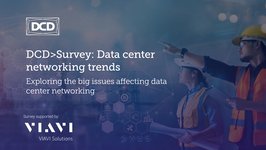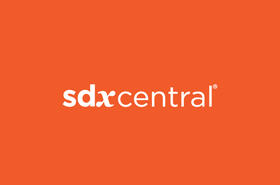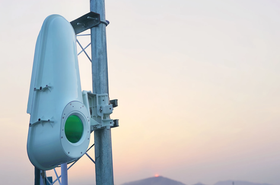DriveNets is well aware that vendors like Cisco and Juniper Networks are big fish in the network pond but knows it can counter that size with greater software agility, an advantage it’s using to score a diverse set of new business.
DriveNets recently scored a pair of deals bolstering the vendor’s two main business units that rely on the same basic underlying disaggregation software, a platform that DriveNets is positioning to help automate the use of artificial intelligence (AI) to more efficiently run operations.
Hillel Kobrinsky, DriveNets' co-founder and chief strategy officer, explained to SDxCentral that DriveNets’ core technology is being used to support both its long-standing service provider operations and a newer one that is focused on AI networking in connecting GPUs.
“It is about implementing a software centric …. a real software-centric network, not for the sake of software, not because it's popular, it's just to allow to do real automation,” Kobrinsky said, adding that this automation is increasingly important to support AI. “Not for them to [sell] AI services in the future, but about them using AI tools that allow them to gain efficiency in operations.”
Toward the service provider side, DriveNets earlier this month signed a deal with Japan-based telecom operator KDDI to deploy disaggregated routers using DriveNets Network Cloud platform at four locations in KDDI’s backbone. The plan is to have these disaggregated core routers powering commercial services by the end of this year.
KDDI explained that the deployment is tied to meeting increased AI-generated data demands.
“Our vision for the future is to build a flexible and robust architecture suited to the AI era, allowing us to swiftly respond to the evolving market needs and set new industry standards,” Kazuyuki Yoshimura, senior managing executive officer, CTO, and GM of KDDI’s Core Technology Sector, noted in a statement.
The KDDI deal extends DriveNets’ push into the service provider space, including deals with AT&T and Comcast.
The AT&T work has the carrier using DriveNets’ Network Cloud software as part of its core router and Internet peering network. This runs on AT&T’s distributed disaggregated chassis (DCC) white-box router architecture.
That collaboration began in 2020, and hit a milestone a couple of years later when AT&T said that disaggregated core platform was carrying more than half of carrier’s network traffic. Igal Elbaz, SVP and network CTO at AT&T, recently updated that number to more than 80 percent of the carrier’s total network traffic running on that disaggregated network core, or nearly 840 petabytes of data per day.
The Comcast agreement has DriveNets’ Network Cloud software running on white-box hardware to support Comcast’s move to virtualize and move its network core, including routing, switching, and transport network function to its edge cloud platform.
Connecting GPUs, storage
DriveNets’ newer business unit also got in on the act, with WhiteFiber this week announcing it has deployed DriveNets Network Cloud-AI as the back end and storage network platform for WhiteFiber’s cloud-based GPU-as-a-service (GPUaaS) offerings. The DriveNets platform is connecting GPUs and GPUs to storage at WhiteFiber’s AI data center in Iceland.
DriveNets’ unveiled its AI-focused platform two years ago. It relies on Ethernet, rather than InfiniBand, to help connect large numbers of AI-optimized systems in a distributed cluster. DriveNets initially claimed this technology approach has the ability to connect up to 32,000 GPUs together in an AI cluster, with bandwidth connectivity of up to 800G.
“We kind of stumbled into the AI market at the beginning of 2023,” DriveNets CMO Inbar Lasser-Raab told SDxCental last year. “Initially, we thought we're not a switch company, but what we found out when a couple of hyperscalers came to us to test our solution, they realized that the way we build the fabric for the router, the way we can scale a router fabric to many white boxes, really created the highest performance switch in the market and the fabric itself is a high-performance switch.
"They tested us as an AI networking solution and we showed them the best result in terms of job completion time, between 10-percent to 30-percent better than other solutions. Because of the nature of the fabric, we don't drop packets, and the switching is done internally in the fabric, so it's very quick.”
Cisco admiration
Kobrinsky noted that DriveNets underlying focus is about altering the current cost and performance structure for networks, something he thinks current vendors are not doing due to rapidly evolving market dynamics. This includes vendors like Cisco moving more aggressively into areas like security and AI, and current unease over Juniper Networks’ direction under the shadow of the pending Hewlett Packard Enterprise (HPE) deal, “and this puts question marks about what will be the future and the resources eventually where they will go,” Kobrinsky said.
“Sometimes people say, ‘guys, you did a great job. You are like Cisco,’” Kobrinsky said. “Not because Cisco is not a good company. Don't, get me wrong, they’re a fabulous company … and I wish someday to be as big as Cisco. … I like them, and I appreciate everything they do and are doing, but I'm bringing new technology, new concepts, a new way of building, designing, redesigning the network. … It's not about a 10-percent cost reduction, it's about changing your cost structure.”
Cisco is also well aware of DriveNets performance capabilities having integrated DriveNets Network Cloud to work with its Acacia optical modules.
While the KDDI and WhiteFiber deals highlight momentum for DriveNets’ pair of business units, Kobrinsky said the evolving service provider and AI landscape will result in tighter integration for the vendor down the road.
“I think eventually it will merge into the service provider because I do see them eventually giving those services GPUs-as-a-service in some combination,” Kobrinsky said. “I don't know the business terms of it, but somehow they will get there because they are close to the customer. They have data centers with electricity in the cities, so it will make a difference in the future. So, in a sense, we are preparing ourselves for them as well.”




